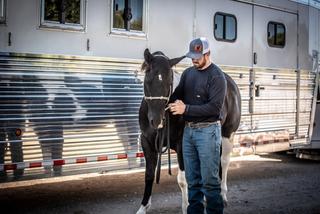Identifying & Preventing Heat Stress in Horses


Horses are very proficient sweaters, making them some of the most efficient animals at cooling themselves, however, they are still at risk for heat stress.
Doing so will replenish electrolytes, encourage more water intake and help prevent dehydration. I do encourage that horse owners add electrolytes to the horse’s feed, not their water, which can make the water taste kind of salty or simply just different from what the horse is used to (meaning less water consumption).
Keep in mind that some groups of horses are at increased risk for overheating. Horses that are overweight, in poor condition or are senior horses are at increased risk. Also, horses that move or are transported from a cooler climate into a hot climate. If these horses are not given time to acclimate, such as being kept in a cool barn with constant fans, they become at increased risk.
Horses with conditions such as PPID (Pituitary Pars Intermedia Dysfunction), known as Cushing’s Disease—are also at risk. A PPID horse will often have a thick, non-shedding hair coat; it’s important that you clip them a few times throughout the warmer months to keep a short hair coat.
Understand the horse heat index to help determine if it’s safe to exercise your horse. Add the day’s temperature in Fahrenheit, plus the percentage of humidity:
- If you’re in the 120 to 150 range, your horse is fine to exercise.
- From 150 to 180, there’s a higher risk—light exercise may be allowed, depending on your horse’s acclimation and fitness level.
- If the horse heat index is over 180, avoid exercising your horse. The risk is too great, unless they’re an elite athlete.
If you exercise your horse, it’s important to cool them down. Their muscles can accumulate a lot of heat during training, and if we just stop, then that heat becomes trapped in that musculature.
Sweating cools the skin surface; we need to keep that blood flowing so that cool blood can be transported back to the muscles to cool them off. Walk your horse for 10 to 15 minutes. After that, let them drink a small amount of water.
The American Association of Equine Practitioners recommends applying cool water to your entire horse, stating, “Spend time hosing his largest muscle areas and the largest and closest-to-the-surface blood vessels, the jugular vein in the neck and the saphenous vein on the inner thigh. Doing this cools the body faster.”
5 Quick Tips for Safety and Comfort
- Schedule feeding around a horse’s training schedule to avoid combining the added heat being produced through muscular activity, exercise and digestion. Feed three to four hours prior to exercise, or wait at least two hours after exercise to feed your horse.
- Install a fan in each horse’s stall. As an added benefit, moving air from a livestock fan will help keep the flies and mosquitoes away.
- Leave barn windows and doors open to increase ventilation.
- If your horses are out on pasture, shade from a simple lean-to will keep them out of the sunshine.
- To protect horses from sunburns and some of the cancers that can develop because of them, look into fly sheets or fly masks that can provide up to 90% UV protection.
Horse owners, please don’t forget to stay hydrated and cool yourself!
Tags:Horse Sense

Acreage Life is part of the Catalyst Communications Network publication family.















